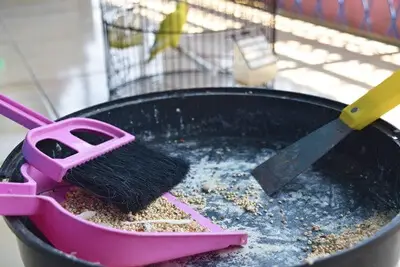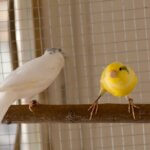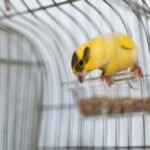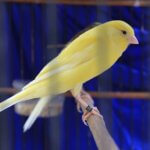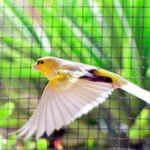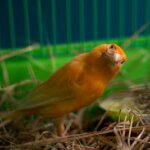Last Updated on: 27th September 2022, 08:32 am
Canaries are clean birds that preen themselves regularly. Nonetheless, they’re still birds; all pet birds drop food, lose feathers, produce feather dust, poop multiple times a day, bathe in their water bowls, etc.
So, cleaning the cage regularly when you own a canary is important. Birds have vulnerable respiratory and immune systems, so they can easily get sick if left in unclean conditions.
Deep-cleaning a canary’s cage weekly and daily spot cleaning are essential.
How To Deep-Clean A Canary Cage
To make the process quick, effective, and stress-free, follow these simple steps:
1/ Remove the Canary
Canaries have sensitive respiratory systems and can grow sick if exposed to cleaning agents. According to the Journal of Environmental Toxicology, some cleaners affect the central nervous systems of birds.
Remove your canary from its cage when deep cleaning. This will ensure it doesn’t get in the way, escape while you’re reaching inside, or become stressed by the activity.
Place the canary in a temporary cage, and ensure there are toys to keep it calm and entertained.
Ensure the perches and toys are exclusive to that cage, so you don’t have to take time swapping out dirty toys with clean toys as you address them.
2/ Remove Items
Remove any toys, swings, perches, and bowls from the cage before you start cleaning.
This allows you to more easily reach any small spaces and corners. Also, you can wash each item individually to be sure it’s clean and sterile.
Even if this appears excessive, bacteria will breed and multiply if it’s not removed.
For example, where a perch attaches to the cage bars may seem clean, but poop or food scraps may be enough to make your canary sick.
Aside from allowing you to clean up all messes easier, this prevents soap and disinfectants from getting into the canary’s food and water bowls.
3/ Move the Cage to the Bathroom
Place the cage in a shower stall so you can easily access detergents, hot water, and a drain. This will be more effective than using a sponge or wet rag to clean the cage.
4/ Take Out the Cage Doors
If the cage has removable doors, take them off, so you can reach inside and access all interior points. This will also make it easier to clean and rinse the edges, where dirt and bacteria hide.
5/ Clean with Hot Water
Never use bleach. While bleach may seem effective, you’re cleansing items your canary will eat, drink, and peck at, and you don’t want to risk chemical inhalation and ingestion.
Using a shower nozzle, hose, or bucket, rinse the cage with clean water, as this will soften any waste and take the initial layer of dirt and debris off the cage.
After that, give it a thorough scrub using a sponge, soap (basic, non-scented soap), and hot water.
Non-scented products will leave behind the least residue, chemicals, or fragrance, which would otherwise adversely affect your canary. You can use bird-friendly disinfectant for hardened messes.
Pay particular attention to the cage’s bars, grates, and base.
6/ Clean Cage Accessories
Now, focus on the canary’s perches, feeding equipment, and toys.
Here, it’s especially important to only use warm water with dish soap or a bird-safe cleaner. They’re mild and don’t remain on items for as long or small as strongly as standard disinfectants.
Once the accessories have been thoroughly cleaned, give each item a thorough rinse.
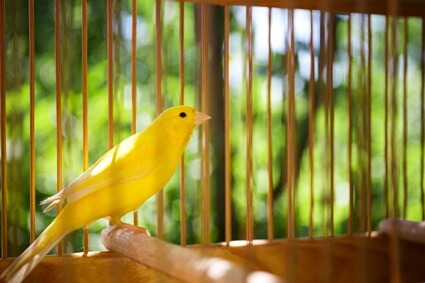
7/ Rinse and Dry The Cage
After rubbing down each part of the cage and its accessories, rinse it with a hose, bucket, or nozzle to clean away all the filth and soap.
Lift it out of the shower stall, or move it away from the cleaning area you’ve finished. Set it on a dry towel and use a second towel to dry the cage and any accessories.
Don’t bring the canary in yet. Let the items air-dry for a few hours, preferably in the sun, to ensure all the moisture, cleaner residue, or scents have a chance to fade.
How To Keep A Canary Cage Clean
If you maintain the cage regularly, you won’t need to perform regular deep cleans.
Here are some tips for keeping your canary’s cage clean and tidy:
Remove Leftovers
Canaries have small appetites, so they often leave their food unfinished.
That’s not a problem when the food bowl contains seed, which is slow to rot. However, canaries benefit from eating fruits and vegetables to round out their diets, and these meals decay sooner.
The longer this food remains in the bowl, the more bacteria accumulate. From here, the chances increase that your canary will get sick when it returns to peck at the leftovers.
So, always remove any leftover food within 1-2 hours. Don’t let the canary’s water sit in the cage for more than a day, as it’ll attract bacteria, especially if it bathes in its water bowl.
Clean Feeding Bowls
After throwing away any leftover food and water, wash the bowls with warm water and bird-safe soap to remove debris and fecal matter.
Afterward, rinse off the soap, pat the items dry, and let them air-dry for an hour or two before returning them to the cage.
Clean Area
Sometimes, air blown by open windows, fans, and air conditioners carries dust, dirt, and debris from the floor and into the cage. So, keep this area of the home clean.
Ideally, sweep the area at least once a day. If you notice any droppings, go a step further and use a warm, soapy sponge to remove any stubborn filth.
This will also make the overall living space and air quality significantly healthier.
Cage Liner Replacement
The cage liner catches the canary’s poop and dropped food. If left to accumulate, they’ll rot, and bacteria will accumulate, making your canary sick. So, replace the liner daily.
To keep costs low, use newspapers or cob beddings. Avoid using anything that produces dust, like cat litter or wood shavings, because canaries have sensitive respiratory tracts.
How Often Should I Clean a Canary Cage?
A canary’s cage should be spot-cleaned daily because birds poop and drop food constantly.
If the cage is large, thoroughly cleaning it once a week will usually suffice. However, smaller cages (15 inches and below) usually fill up faster and need to be cleaned 2-3 times a week.
However, follow visual cues rather than a calendar date. Check for signs of dirt and debris accumulation, and clean the cage before a problem takes hold.

